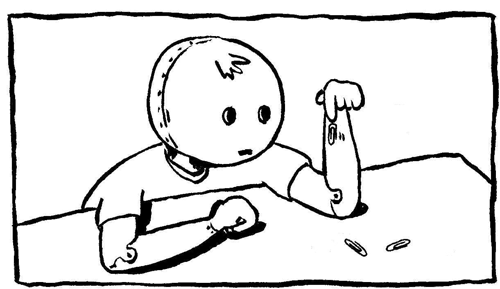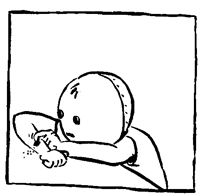Interview
Post-apocalypse, Poetry, and Robots
A conversation with Matthea Harvey about Modern Life.
Introduction
Matthea Harvey's latest book, Modern Life, explores the dysfunction between civilian and military populations in a stark, futuristic environment. Jeannine Hall Gailey interviews Harvey about the post-apocalyptic landscapes, human-robot hybrids, and echoes of Japanese anime in her book.

Photo by R. Casper.
Matthea Harvey’s latest book, Modern Life, a finalist for the National Book Critics Circle Award, is obsessed with devastated worlds and hybrid forms of life. Her poems have always teemed with witty wordplay, but now they come with an undercurrent of trauma. In two extended abecedarian sequences, the “Terror of the Future” and “The Future of Terror,” Harvey explores the dysfunction between civilian and military populations in a stark, futuristic environment. In the “Robo-Boy” series of poems, a robot-boy struggles to define himself in human terms while confronting a brutal and confusing world.
The themes in Modern Life eerily echo those of classic Japanese anime, with which many Americans have become obsessed in the aftermath of September 11. In a recent e-mail exchange, I asked Harvey whether those parallels were at work in Modern Life, and about other influences on her work.
Jeannine Hall Gailey: Are you interested in Japanese pop culture? If so, do you have any favorite anime?
Matthea Harvey: I love [Hayao] Miyazaki’s Spirited Away and Howl’s Moving Castle. There is such freedom of invention in both of them. In the same way that a strong voice in a poem can transport you anywhere, that distinctive animation style lets you surrender to the story. The characters are wonderful—I am a particular fan of the mysterious No Face, a black figure with a white mask face who seems connected to the Noh tradition, and the critterly Susuwatari, soot sprites that are essentially fuzzy black spheres with big eyes.
Do you think the images and themes of manga and anime have permeated our artistic sensibilities? Have cyborgs and post-apocalyptic landscapes affected your writing?
I think many cultures are interested in post-apocalyptic landscapes and human-robot hybrids—we’re always projecting ourselves into the future, aren’t we? The post-apocalyptic world of “The Future of Terror” and “Terror of the Future” arose in the writing. My interest in hybrids may go back to the centaurs in Greek mythology and, in The Chronicles of Narnia, the mermaids. I can’t remember a time when I wasn’t interested in hybrids. I recently found some mind-boggling photo-hybrids online by Khoa Tran—a cat-penguin, a horse-duck, and a dog-gull, among others. And I’ve just remembered how enchanted I was by Charles Kingsley’s The Water-Babies.

When I first read your Robo-Boy poems, I immediately thought of the early-fifties Japanese anime series Astro Boy, which is about a boy-robot hero powered by nuclear energy who tries to save the world from various villains and disasters. Astro Boy ponders questions of free will and good and evil despite his robotic form.
Robots are another old love. My first robot crushes were R2-D2 and K9, Doctor Who’s robot dog. I didn’t know anything about Astro Boy until you mentioned him to me, but reading about him and watching a few episodes, he’s clearly Robo-Boy’s cooler cousin. I particularly love that Astro Boy prefers the cube shape to the shape of a flower, and I liked the scene in which his skin suit is pulled over his robot body. Astro Boy (with his rocket legs and laser fingers) is much more powerful than Robo-Boy, though: He’s a force for good in the world, whereas Robo-Boy is just trying to muddle through, like we are. I liked writing about him because of his different perspective on the human, especially those things we take for granted, such as fingerprints and experiencing the full palette of emotions.
One of the things I find most interesting is Robo-Boy’s struggle to be both fully human and fully machine, a common theme in anime series such as Ghost in the Shell and FullMetal Alchemist and in Miyazaki's works, such as Nausicaä of the Valley of the Wind. Does Robo-Boy personify our discomfort and fear that technology is dehumanizing us?
 I wasn’t consciously thinking about our fears about technology (though I dislike the slightest change to my computer). Robo-Boy’s struggle is part of the whole book’s concern with being in the middle of things—cat/goat, poetry/prose (I think the equator probably feels that it is in an uncomfortable position). In Robo-Boy’s case, his struggle is as you describe it: being half-machine and half-human. Somehow, that struggle seems to magnify the human struggles we all go through: who am I, where do I fit in, etc. For that reason, and because I wanted his own struggle about identity to be mirrored in the reader’s perceptions, I was careful not to describe his physical characteristics too much—I wanted him to shimmer between people’s ideas of what a robot looks like and what a boy looks like. I admired how with Anne Carson’s Autobiography of Red, you sometimes forget that Geryon is a red monster. But now let me contradict myself: Delirium Press published a limited edition chapbook of the Robo-Boy poems called No One Will See Themself in You, and Doug McNamara did the illustrations. His Robo-Boy was quite mechanical (you could see the rivets on his head) but incredibly human in affect. That preserved the shimmer, I think.
I wasn’t consciously thinking about our fears about technology (though I dislike the slightest change to my computer). Robo-Boy’s struggle is part of the whole book’s concern with being in the middle of things—cat/goat, poetry/prose (I think the equator probably feels that it is in an uncomfortable position). In Robo-Boy’s case, his struggle is as you describe it: being half-machine and half-human. Somehow, that struggle seems to magnify the human struggles we all go through: who am I, where do I fit in, etc. For that reason, and because I wanted his own struggle about identity to be mirrored in the reader’s perceptions, I was careful not to describe his physical characteristics too much—I wanted him to shimmer between people’s ideas of what a robot looks like and what a boy looks like. I admired how with Anne Carson’s Autobiography of Red, you sometimes forget that Geryon is a red monster. But now let me contradict myself: Delirium Press published a limited edition chapbook of the Robo-Boy poems called No One Will See Themself in You, and Doug McNamara did the illustrations. His Robo-Boy was quite mechanical (you could see the rivets on his head) but incredibly human in affect. That preserved the shimmer, I think.
I spent a good bit of the fall making cardboard robots and spray painting them silver on my roof (I had a Halloween robot book party when Modern Life came out), and it reinforced something that Scott McCloud talks about in Understanding Comics: how quick we are to see human qualities—for example, we see a face in two dots and a semicircle. It’s a bit sad to think we’re a species scurrying around looking for reflections of ourselves, but also sweet.
The post-apocalyptic tone in “Terror of the Future” and “The Future of Terror” seems to me clearly focused on the anxieties of Americans post–September 11. Roland Kelts, among others, has compared our bewilderment after September 11 to the bewilderment of the Japanese after World War II.
The book was written post-9/11, and the terror and anger in the book are partly from that event, but I think the poems address that in a general way (paradoxically by being very specific). “The Future of Terror” and “Terror of the Future” series are set in an apocalyptic time in the future—I didn’t imagine any particular country—so it makes sense that the anxiety in them could apply to any war-time. Terror doesn’t know historical or national boundaries.
In an interview with Bookslut, you mention reading graphic novels. What are your favorites? Are they mostly American, or have you read any Japanese or Korean manga?
I haven’t read much manga. Some of my favorite graphic novelists are Paul Hornschemeier, Chris Ware, Lauren Weinstein, Rebecca Kraatz, Renée French, Gabrielle Bell, Alison Bechdel, Posy Simmonds, Lewis Trondheim, and Graham Roumieu. Have you read Roumieu’s Me Write Book: It Bigfoot Memoir or In Me Own Words? If not, you must—they’re laugh-out-loud great. I’m also a huge fan of minicomics—I think Lark Pien, Fay Ryu, Doug McNamara, Briana Miller, Tom Gauld, Jamie Tanner, and APAK (Ayumi and Aaron Piland) are all brilliant. When something is tiny, maybe the little arrows of heartbreak penetrate more easily—slip in through a tear duct or a pore.
Your work is very visual, even in its layout. It’s almost as if you’re a poet who thinks like a graphic novelist. Do you think your poetry would make for a good graphic novel? Are you a frustrated artist in disguise? When I read Modern Life, I kept picturing images from the Japanese Superflat pop art movement, especially the works of female artists such as Yumiko Kayukawa and Chiho Aoshima, who create strange, otherworldly images that seem, like Modern Life, at once playful and menacing.
I like the combination of playful and menacing . . . like a sugarcoated Combo with razor blades mixed into the peanut butter. And I enjoy the work of the Superflat artists—Yoshitomo Nara’s “cutism.” I would love to have every one of my poems translated visually. I hope more of that kind of collaboration comes into my life. I’ve worked with a few artists—Doug McNamara, whom I mentioned before; Elizabeth Zechel, who illustrated my children’s book, The Little General and the Giant Snowflake; and Amy Jean Porter, who is working with me on a project called Of Lamb, which is based on my erasure of a biography of Charles Lamb.
My older sister, Ellen Harvey, is an artist, and I do envy her talent. I would love to be able to draw. I started taking photographs a while ago, mostly of miniature constructed scenes—sugar houses, the dominoes on the cover of Modern Life, little stacked boxes of sky. It has been a delight to approach invention so visually. I’m in Iowa City this semester, and when my flight to New York [for the Associated Writing Programs conference] was canceled last weekend, I consoled myself by taking photographs of pink dollhouse teacups filled with snow.
Homepage photo of Matthea Harvey by R. Casper. “Robo-Boy” artwork by Doug McNamara from the limited-edition chapbook No One Will See Themself in You, published by Delirium Press.
Jeannine Hall Gailey is the author of five books of poetry: Becoming the Villainess (2006), She Returns to the Floating World (2011; 2013), Unexplained Fevers (2013), The Robot Scientist’s Daughter (2015), and Field Guide to the End of the World (2016), winner of the Moon City Press Book Prize. Her work has been featured on NPR’s The Writer’s Almanac and in The Year’s Best Fantasy and Horror. Her ...


